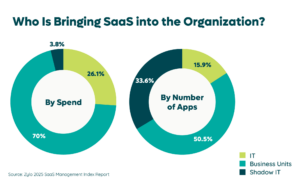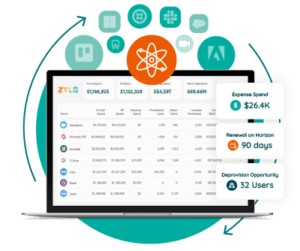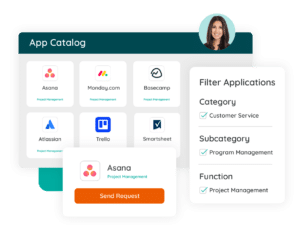Table of Contents
Until recently, IT departments managed all software acquisition for their companies. But as businesses increasingly adopted SaaS for their needs, especially once the pandemic hit, another trend emerged — decentralization.
Today, various business leaders and individual employees increasingly purchase SaaS unbeknownst to IT, as downloading a new tool only requires a corporate credit card. Zylo’s SaaS Management Index shows that, today, business units own 70% of SaaS spend, while individual SaaS expenditure sits at 3.8% of total SaaS spend%.

In order to empower employees while mitigating security and compliance risks, learn from these best practices to master decentralized SaaS governance at your organization.
What Is Decentralized SaaS Governance?
Decentralization occurs when employees have the freedom to select and purchase their own SaaS. While decentralization may lead to increased productivity and autonomy, it poses some business threats. SaaS purchased by various departments typically doesn’t receive IT vetting for security and compliance risks. Additionally, decentralized governance may increase IT costs if employees purchase duplicate software, or make one-off purchases instead of leveraging IT to negotiate enterprise agreements.
If governance feels like Goldilocks and the Three SaaS Apps, you may find the flexibility you want in a concept we call freedom within a framework. This model allows you to get the benefits of a decentralized approach – the ability for employees to select their tools, while still keeping some key guardrails in place to protect your organization.
Evolving Your SaaS Governance Framework for the Digital Workplace
Learn MoreDecentralized Governance without the Risk
Follow these freedom within a framework best practices to realize the benefits of decentralized governance without putting your organization at risk.
1. Discover All SaaS
 The first step requires gaining a clear understanding of all the applications within your company, whether purchased by IT or individual employees. Throughout the discovery process, evaluate any unvetted software and eliminate any tools deemed problematic. Zylo’s Discovery Engine finds 100% of your applications and provides real-time reporting to keep you apprised of apps entering and exiting your organization.
The first step requires gaining a clear understanding of all the applications within your company, whether purchased by IT or individual employees. Throughout the discovery process, evaluate any unvetted software and eliminate any tools deemed problematic. Zylo’s Discovery Engine finds 100% of your applications and provides real-time reporting to keep you apprised of apps entering and exiting your organization.
2. Establish a SaaS Review Process
Next, build your framework by establishing a centralized review and approval process for SaaS purchases. Build out a review committee, which could be as simple as your IT manager, but might include others if you work for a large company. Task this committee with accepting app requests, cross verifying them against existing SaaS, and vetting application security to ensure compliance and reduce risk.
Zylo research shows the average company sees six applications enter its environment and four exit every 30 days. Creating a framework within an environment that continues to add new apps complicates the process, so it’s wise to place a moratorium on app acquisition while building out your review and approval process.
How the Zylo Discovery Engine Powers the Most Comprehensive SaaS Management Platform
Learn More3. Curate an App Catalog
With discovery and a review process ironed out, use the findings to build an in-house library of vetted applications. Then, give your employees freedom to select the tools they need to be successful. Anything outside the catalog goes through the review process you established. An app catalog comes with numerous benefits, including:
 Employees know the SaaS tools available to them
Employees know the SaaS tools available to them- Prevents duplicate purchases
- Reduces redundancies among apps with functional overlaps
- Saves valuable IT time and resources
4. Improve Utilization
Set it and forget it doesn’t apply to your SaaS library. It must be continuously monitored for utilization. Prune out unused apps and be on the lookout for new best-in-class software for your team. To make the most of your investment, aim for a 90% utilization rate.
5. Accept Feedback
Remember, this is a tool for your entire organization. In order to ensure employee satisfaction, regularly survey the company. Use the results to determine whether you have the right apps in your catalog or need to explore alternatives.
The pandemic introduced a new level of flexibility into the workplace, and today’s employees expect it to stay.
Helen Kupp, head of product strategy and partnerships at Future Forum (Slack) discussed this during our SaaSMe 2021 event.
“Employees continue to have a strong preference for this flexibility. We saw 76% of global knowledge workers want flexibility in where they work,” Kupp says. “More importantly, we’re finding employees are going to vote with their feet in terms of what they want from their employers. The same study showed flexibility ranks second only to compensation when it comes to job satisfaction.”
Want more insight on decentralized SaaS governance? Hear more from Kupp, along with speakers from Redis and Talkdesk, in the on-demand SaaSMe 2021 sessions.


 Employees know the SaaS tools available to them
Employees know the SaaS tools available to them